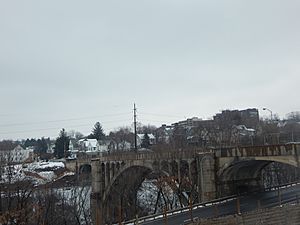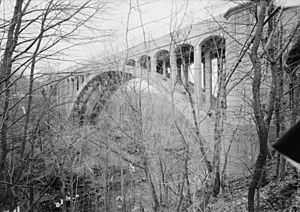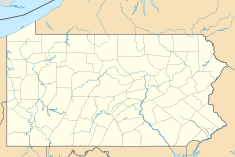Harrison Avenue Bridge facts for kids
Quick facts for kids Harrison Avenue Bridge |
|
|---|---|

The Harrison Avenue Bridge in March 2015, with the Central Scranton Expressway under the right-most arch.
|
|
| Carries | Harrison Avenue (State Route 6011) |
| Crosses | Roaring Brook and Central Scranton Expressway |
| Locale | Scranton, Pennsylvania |
| Other name(s) | South-East Scranton Viaduct |
| Maintained by | PennDOT |
| Characteristics | |
| Design | Open-spandrel deck arch |
| Material | Concrete |
| Total length | 407 feet (124 m) |
| Width | 40 feet (12 m) |
| Longest span | 202 feet (62 m) |
| Number of spans | 3 |
| History | |
| Designer | Abraham Burton Cohen |
| Constructed by | Anthracite Bridge Company |
|
Harrison Avenue Bridge
|
|

The Harrison Avenue Bridge in 1999.
|
|
| Area | less than one acre |
| Built | 1922 |
| MPS | Highway Bridges Owned by the Commonwealth of Pennsylvania, Department of Transportation TR |
| NRHP reference No. | 88000767 |
| Added to NRHP | June 22, 1988 |
The Harrison Avenue Bridge was a special concrete bridge in Scranton, Pennsylvania, United States. It carried Harrison Avenue (also known as State Route 6011) over Roaring Brook and other important paths. This bridge was known for its unique design and its interesting history. It was a big part of the Scranton community for many years.
Contents
What Was the Harrison Avenue Bridge?
The Harrison Avenue Bridge was a type of bridge called an arch bridge. It had three main arches, which are like big curved supports. The middle arch went over Roaring Brook, a local stream.
The other two arches crossed old railroad lines. One of these old lines later became the Central Scranton Expressway, a major road for cars. The other old railroad line is now a heritage railroad. This means it's used for fun train rides by Steamtown National Historic Site.
How Was the Bridge Built?
The Harrison Avenue Bridge was built a long time ago, between 1921 and 1922. It was made from strong concrete. The bridge was designed to be very sturdy and to last a long time.
Who Designed and Built It?
A famous engineer named Abraham Burton Cohen designed the bridge. He was from New York City. Even though he designed it, local engineers were very involved. William A. Schunk and Charles F. Schroeder from Scranton helped supervise the building every day. The company that built the bridge was called the Anthracite Bridge Company.
Why Was It Important?
The Harrison Avenue Bridge was important for a few reasons. It showed how people in the community could work together. A group of citizens called the South to East Scranton Bridge Association helped push for the bridge to be built. This was during a time called the Progressive Era, when people wanted to improve cities.
The bridge was also special because of its design. In 1988, it was listed on the National Register of Historic Places. This means it was recognized as an important historical structure in the United States.
What Happened to the Old Bridge?
Over time, the old Harrison Avenue Bridge became very old. So, a new bridge was built right next to it. Construction on the new bridge started in October 2014 and finished in December 2017.
After the new bridge was ready, the old Harrison Avenue Bridge was taken down. It was demolished in June 2018. Even though the old bridge is gone, its history and design are still remembered.


